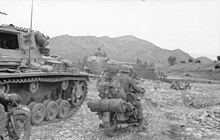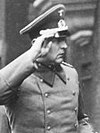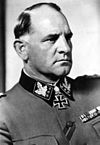| This article includes a list of general references, but it lacks sufficient corresponding inline citations. Please help to improve this article by introducing more precise citations. (July 2016) (Learn how and when to remove this message) |
| 5th Panzer Army | |
|---|---|
| 5. Panzerarmee | |
 5th Panzer Army 5th Panzer Army | |
| Active |
|
| Country | |
| Branch | |
| Type | Panzer |
| Role | Armoured warfare |
| Size | Army |
| Engagements | |
| Commanders | |
| Notable commanders | |
5th Panzer Army (German: 5. Panzerarmee) was the name of two different German armoured formations during World War II. The first of these was formed in 1942, during the North African campaign and surrendered to the Allies at Tunis in 1943. The army was re-formed in France in 1944, fought in Western Europe and surrendered in the Ruhr pocket in 1945.
History
Formation in Italy and deployment in North Africa
On 17 November 1942, the Stab Nehring staff, assigned to the German general in Rome, was reformed to become the LXXXX Army Corps. This staff was soon repurposed to become the 5th Panzer Army.
The 5th Panzer Army was created on 8 December 1942 as a command formation for armoured units forming to defend Tunisia against Allied attacks which threatened, after the success of the Allied Operation Torch landings in Algeria and Morocco. The army fought alongside the Italian First Army as a part of Army Group Afrika. The army capitulated on 13 May 1943, along with its commander Gustav von Vaerst.
Normandy
The army was reformed on 24 January 1944 as Panzergruppe West ("Panzer Group West"), the armoured reserve for Oberbefehlshaber West. The new army was placed under the command of Leo Geyr von Schweppenburg. The method of employment of Panzer Group West in the event of an allied invasion was the subject of much controversy, with OB West commander Gerd von Rundstedt and Army Group B commander Erwin Rommel favouring different methods. Rundstedt and von Schweppenburg believed that the panzer group should be held in reserve some distance from the front, to counter-attack Allied penetrations. Rommel was convinced that Allied air power and naval artillery would not allow the Germans the freedom to move large formations and so insisted that the panzers should be deployed much closer to the front line. Adolf Hitler forced an unhappy compromise on the western commanders and refused to allow them to commit the panzer group without his authority. When the Allied invasion of France began on 6 June 1944, Panzer Group West remained immobile; by 8 June, Geyr had been able to rush three panzer divisions northward to defend Caen against British and Canadian forces. Geyr planned to launch the divisions in a counter-attack that would drive the British and Canadians back into the sea. On 10 June, Schweppenburg was wounded and most of his staff killed when the RAF attacked his headquarters at La Caine. Geyr's tank units managed to limit the British advance for another month but he was relieved of his command on 2 July, after seconding Rundstedt's request that Hitler authorize a strategic withdrawal from Caen. On 2 July he was replaced by Heinrich Eberbach. The panzer group fought against the Allied forces in Normandy, suffering heavy losses and eventually finding many of its divisions trapped in the Falaise Pocket. After the shattered remnants of the panzer group escaped from the pocket at the end of August, it began a retreat towards the German border.
Retreat, Ardennes
In August 1, 1944, the remaining elements of Panzer Group West were reorganized as the 5th Panzer Army, with a combat formation remaining in action under the title Panzer Group Eberbach. After a brief period under the Waffen-SS commander Sepp Dietrich, command of the army passed to Hasso von Manteuffel. The army saw heavy combat on the German border against Allied forces, the panzer divisions suffering heavily from Allied ground attack aircraft. In November the 5th Panzer Army began forming up in the Ardennes, alongside the newly formed 6th SS Panzer Army under Dietrich. Both formations took part in the Battle of the Bulge, the Fifth Panzer Army became the main central force advancing westwards from the pre-existing front lines after the planned schwerpunkt assigned to the Sixth Panzer Army was stopped at the Elsenborn Ridge and the Ambleve Valley. The Fifth Panzer Army suffered heavy losses in battles around Bastogne and in the armour battles around Celles and Dinant, the westernmost points of advance. After the offensive was cancelled, it continued its fighting withdrawal to the German border. In March, it was involved in efforts to eliminate the American bridgehead over the Rhine at the Ludendorff Bridge in Remagen. The 5th Panzer Army was encircled and trapped in the Ruhr Pocket, and surrendered on 17 April 1945.
Commanders
Fifth Panzer Army (North Africa)
| No. | Portrait | Commander | Took office | Left office | Time in office |
|---|---|---|---|---|---|
| – |
 | Ziegler, HeinzGeneralleutnant Heinz Ziegler (1894–1972) Acting | 3 December 1942 | 20 February 1943 | 79 days |
| 1 |
 | Arnim, HansGeneraloberst Hans-Jürgen von Arnim (1889–1962) | 20 February 1943 | 28 February 1943 | 8 days |
| 2 |
 | Vaerst, GustavGeneral der Panzertruppe Gustav von Vaerst (1894–1975) | 28 February 1943 | 9 May 1943 | 70 days |
Panzer Group West
| No. | Portrait | Commander | Took office | Left office | Time in office |
|---|---|---|---|---|---|
| 1 |
 | Schweppenburg, LeoGeneral der Panzertruppe Leo Geyr von Schweppenburg (1886–1974) | 19 November 1943 | 2 July 1944 | 228 days |
| 2 |
 | Eberbach, HeinrichGeneral der Panzertruppe Heinrich Eberbach (1895–1992) | 4 July 1944 | 9 August 1944 | 36 days |
Panzer Group Eberbach
| No. | Portrait | Commander | Took office | Left office | Time in office |
|---|---|---|---|---|---|
| 1 |
 | Eberbach, HeinrichGeneral der Panzertruppe Heinrich Eberbach (1895–1992) | 10 August 1944 | 21 August 1944 | 11 days |
Fifth Panzer Army (France)
| No. | Portrait | Commander | Took office | Left office | Time in office |
|---|---|---|---|---|---|
| 1 |
 | Eberbach, HeinrichGeneral der Panzertruppe Heinrich Eberbach (1895–1992) | 2 July 1944 | 9 August 1944 | 38 days |
| 2 |
 | Dietrich, SeppSS-Oberst-Gruppenführer Sepp Dietrich (1892–1966) | 9 August 1944 | 9 September 1944 | 31 days |
| 3 |
 | Manteuffel, HassoGeneral der Panzertruppe Hasso von Manteuffel (1897–1978) | 9 September 1944 | 8 March 1945 | 180 days |
| 4 |
 | Harpe, JosefGeneraloberst Josef Harpe (1887–1968) | 8 March 1945 | 17 April 1945 | 40 days |
Order of battle (North Africa)
As of April 1943.
- Manteuffel Group
- 334th Infantry Division
- 999th Light Division
- Hermann Goering Division
- 10th Panzer Division
- Italian Superga Infantry Division
Footnotes
- Tessin, Georg (1977). "Generalkommando LXXXX. Armeekorps (röm. 90. AK)". Die Landstreitkräfte 71-130. Verbände und Truppen der deutschen Wehrmacht und Waffen-SS im Zweiten Weltkrieg 1939-1945 (in German). Vol. 6. Osnabrück: Biblio Verlag. p. 110. ISBN 3764810971.
- Harrison 1951, p. 247.
- "German Command and Tactics in the West, 1944". 4 August 2020.
- Harrison 1951, pp. 249–251.
- Harrison 1951, p. 333.
- "5.Panzer-Army – Ardennes Preparation (Gen Hasso von Manteuffel)". eucmh.com. 23 September 2022.
- MacDonald 1973, p. 370.
- The Army at War:Tunisia HMSO 1944 p.43
Bibliography
- Harrison, Gordon A. (1951) . The Cross Channel Attack. United States Army in World War II: The European Theater of Operations (online ed.). Washington, DC: Off. of the Chief of Military History, Dep. of the Army. OCLC 835823314. Archived from the original on 26 February 2014. Retrieved 1 July 2016.
- MacDonald, Charles B. (1973). The Last Offensive. United States Army in World War II: The European Theater of Operations (online ed.). OCLC 569757222. Retrieved 1 July 2016.
| Armies of the German Army in World War II | |||||||||||||
|---|---|---|---|---|---|---|---|---|---|---|---|---|---|
| Armies |
| ||||||||||||
| Panzer | |||||||||||||
| Parachute | |||||||||||||